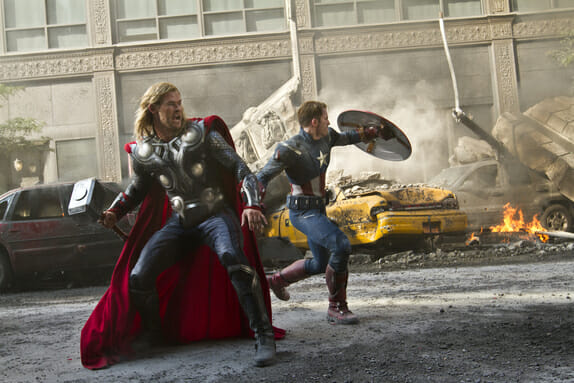
Too often, a superhero film is an exercise in missing the point. This can have as much to do with a failure in basic, dramatic execution as it does with the oft-challenging prospect of translating gaudy costumes, monstrous forms and wildly diverse powers from printed page (and fan imagination) to the Big Screen. That’s why for every Batman Begins there’s a Batman Oh-God-Make-It-Stop, for every X-Men 2 and Spiderman 2, there’s, alas, an X-Men: The Last Stand and Spiderman 3. Granted, at least for the studios behind the Marvel titles, there hasn’t been much reason to sweat missing the point. Of the 21 or so films, all but four have grossed more than double their budgets, with only Elektra “just” breaking even and Punisher: War Zone posting a clear loss. Obviously, there’s plenty of money to be made whether or not one “gets it.”
Fortunately for both casual movie-goer and comic book aficionado alike, Joss Whedon gets it. As a result, The Avengers not only stands out as one of the best efforts in the modern era of “super” movies, it also represents the most complete manifestation of the superhero team aesthetic yet seen on film. (Apologies to the X-Men films—and as far as I’m concerned, the Fantastic Four films owe me an apology.)
To be fair, Whedon had plenty of help, both from long-term studio strategy (there’s a rarely heard kudo for you) and cast. Regardless of what one thinks of the single-hero titles that preceded it, Marvel Studios’ steady roll-out of Iron Man, Thor, Hulk and Captain America movies, allows the The Avengers to be blessedly unburdened by the crippling “origin-itis” that afflicts so many initial efforts in the genre. They’ve also given time for the principals to establish their take on some of Marvel’s most iconic characters. For Chris Evans (Captain America) and Chris Hemsworth (Thor), this has meant mainly reaching a “works in that role” consensus. For the Hulk, it’s allowed valuable tweaking of the CGI technology that brings him so smashingly to life. (And in The Avengers, Hulk smash. Hulk smash sooooo good!) But it’s with Robert Downey Jr.’s quip-happy Iron Man that the approach has borne the most fruit.
Unlike Thor and Captain America, whose actors stay well within the personality profiles proscribed by their characters, Downey Jr.’s Tony Stark is pretty far removed from Marvel’s often morose, dependably self-destructive industrialist. And honestly, it’s a welcome change. Downey Jr. may be the ideal delivery system for Whedon’s signature banter—a banter that permeates and propels the plot of the two-hour film along just as effectively as the set action pieces.
As for the plot—it’s the stuff of which basic, dependable comic book arcs are made. Thor’s mischievous half-brother, Loki (Tom Hiddleston), gets his hands on the Tesseract (the more alliteratively named Cosmic Cube in the original comics) and promises some good-ol’-fashioned world conquering by means of an alien army. (Forget Zod—kneel before the guy in the silly helmet.) Nick Fury (Samuel L. Jackson) gathers the most powerful folks he knows—and the Black Widow (Scarlett Johansson)—to fight the threat. Before that can happen, of course, the good guys have to bicker and fight among themselves. (“Will our heroes ever learn to play well with each other?!”)
Though a time-honored component of most hero ensemble pieces (regardless of medium), such clashes are too often tedious and forced, a hackneyed means of fleshing out a second act. That’s not the case in The Avengers. Thanks in large part to the Downey Jr.-powered snark-generating machine, the friction between the heroes actually makes sense.
While Whedon smartly recognizes how key Downey Jr.’s Stark is to the story, he also allows most all of his cast, heroes and villain, ample opportunities to shine, both in dialogue and action. (Hawkeye and Nick Fury, not so much.) It can’t be overstated how crucial such balance is to a team film. As Loki, Hiddleston may be the best-cast arch-villain since Ian McKellen’s Magneto. (This bodes well for the “shared universe” Marvel Studios is building. Just as in its comic books, Marvel needs its villains to emit suitable levels of dastardliness. Let’s just hope there are enough British stage and screen actors to supply its needs.) The rest of the principals—particularly Hemsworth, Evans and Ruffalo—inhabit their characters so seamlessly, the viewer can just move straight to the wonder and fun of it all.
But The Avengers’s impending blockbusting will not just be the result of stellar casting. Throughout the film, Whedon allows much of the action to proceed at superhero pace—“placing” the camera for best vantage rather than over-indulging in bullet-time and other tricks. When he does slow things down—such as when Thor lands the first hammer-to-yo’-face blow on Hulk—there’s an obvious dramatic advantage gained. (It helps that three of the Avengers—Thor, Hulk and Iron Man—are basically invulnerable battle machines.) This is as groundbreaking as any box office numbers, no matter how high they climb.
Finally. A director who understands that one doesn’t shoot each and every use of a super power, or the clash between them, as some rare event the camera must slobber over in slow-motion. And finally, a director who gets the point instead of misses it—and a studio that is smart enough to hand him the reins.
Director: Joss Whedon
Writer: Zak Penn & Joss Whedon (story); Joss Whedon (screenplay); Stan Lee & Jack Kirby (comic book)
Starring: Robert Downey Jr., Chris Evans, Mark Ruffalo, Chris Hemsworth, Scarlett Johansson, Jeremy Renner, Tom Hiddleston, Clark Gregg, Cobie Smulders, Stellan Skarsgård, Samuel L. Jackson
Release Date: May 4, 2012